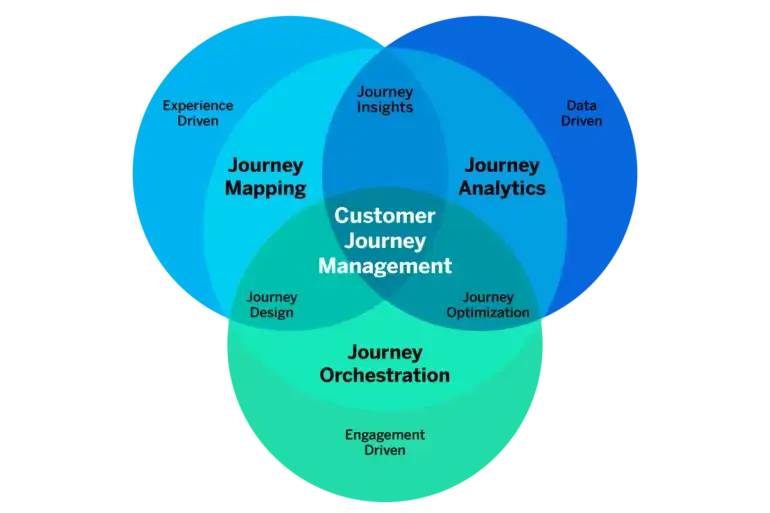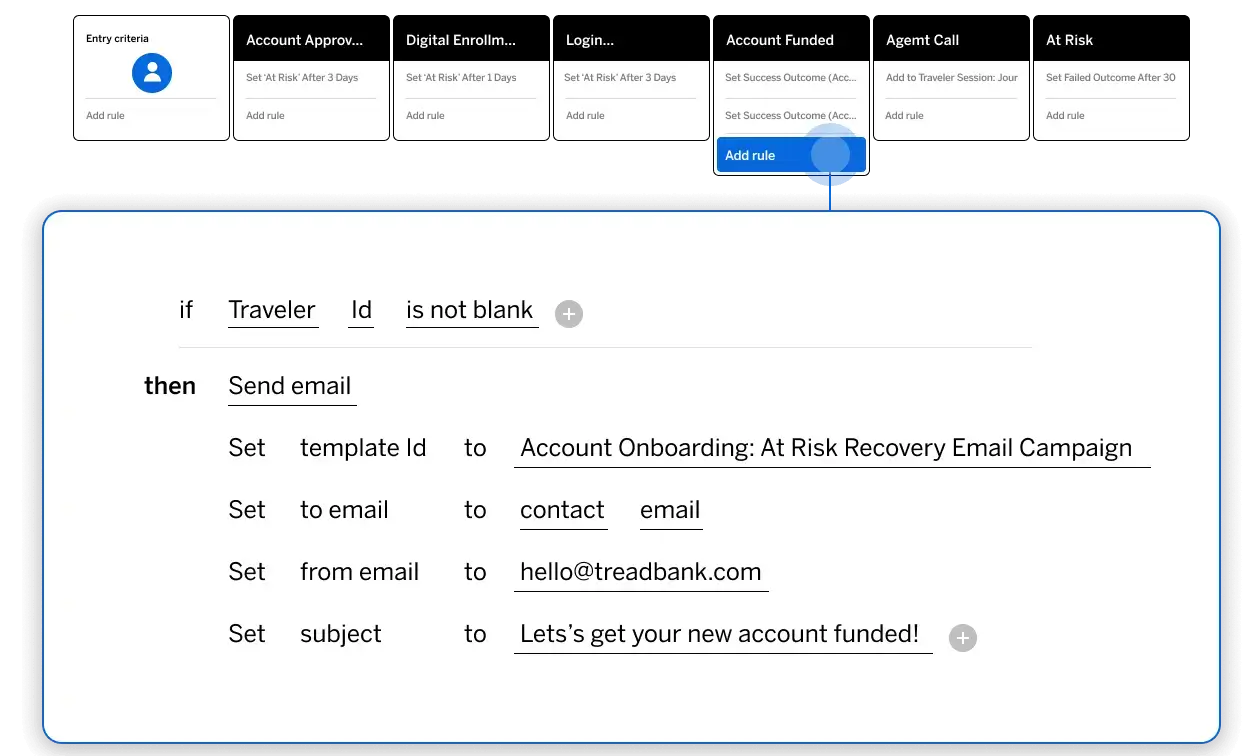Author: Adam Bunker
Subject matter expert: Dave Pabley
What is customer journey orchestration?
Customer journey orchestration is a strategy for optimizing the customer experience by leveraging real-time insights into their behaviors. It’s an approach that enhances traditional customer journey analytics by taking targeted actions to personalize journeys as they occur – in real-time and at scale.
To make things more personalized, journey orchestration replaces the conventional method of using customer segments or personas with real-time, dynamic personalization based on customer behaviors and actions.
Journey orchestration helps businesses act as the conductor of an orchestra, optimizing each customer’s journey using real-time insights on a more proactive level than simply sending data and insights to marketing or sales departments. Instead, it’s a strategy for building a more holistic approach to customer journey management – and providing actionable data across the organization.

The ultimate goal of journey orchestration is to create individual customer experiences that align perfectly with each customer’s specific needs. And for businesses, that often results in an enhanced conversion rate, a reduced cost-to-serve, and improved customer satisfaction.
Free Course: Customer journey management & improvement
What’s the difference between customer journey mapping and orchestration?
Customer journey mapping is a vital practice for any business looking to fine-tune the customer experience. It’s the art of understanding how people interact with your brand, what touchpoints they land on, in which order, and how they’re intertwined.
You might have a ton of different customer journey maps for different audience segments and customer behavior types, but those maps are only really useful if you then work on how to streamline the journey and tighten all the screws.
That’s where customer journey orchestration comes in – it’s how you’ll take what you’ve learned from your mapping exercise, add real-time data, and work to improve each channel and touchpoint along those journeys.
What’s the difference between journey orchestration and dedicated campaign journeys?
Whereas specific marketing campaigns design journeys in advance that a brand wants customers to travel along, true journey orchestration aims to enable a change in behavior.
In practice, that means making changes when they’re needed, based on existing behaviors that are negatively affecting retention or conversion. Think of it this way: designing a campaign is like building a new road from an existing city to a brand new one. Journey orchestration is like noticing that people are trying to make a journey between two existing cities, and new building roads to help them.
Why is customer journey orchestration important?
There are a huge number of benefits to successful customer journey orchestration, and they all center around exceeding customer expectations.
Through customer journey orchestration, you’ll…
1. Become more competitive and connected
With so many choices, consumers find it easier than ever to jump from one brand to another. Bad experiences can spell disaster for customer retention – 42% of customers cut their spending with a brand after a bad experience.
So, in an era where customers have endless choices, those negative experiences can significantly impact retention. Journey orchestration, then, helps cultivate a customer-centric approach, leading to improved connections between your brand and your customers.
Taking a customer-centric approach to the customer experiences you create means that you work “outside in”. Rather than assuming what customers will do, or hoping that they act in a way that benefits you, you need to listen to what they say and how they actually act.
This customer-centricity helps your audience to feel more connected to your brand.
2. Create seamless customer omnichannel experiences
Real-time action based on customer behavior leads to more personalized experiences. Using modern customer experience software with machine learning tools, for example, can help create unique journeys that match each customer’s individual needs, leading to better relationships and higher engagement.
Obviously, using metrics such as Net Promoter Score (NPS), Customer Satisfaction Score (CSAT), and more can help you to judge how customers feel about the experience you provide, but taking immediate action based on real-time behavior gives you an advantage you can’t replicate with other tools.
That way, rather than guessing what the customer’s intent is, or finding that out once it’s too late, you’re able to send them on individualized experiences that match their needs.
3. Work more effectively with your internal teams
Orchestrating journeys also facilitates improved cooperation between your marketing, sales, customer service, and operations teams, leading to comprehensive, seamless customer experiences.
Breaking down silos within your business that might hamper your customer experience means you won’t miss crucial contextual information that could affect each interaction’s success.
Customer journey orchestration examples
Here are a few examples of how customer journey orchestration can positively affect business outcomes by demonstrating empathy and adding value:
Example: Onscreen popups
Outcome: Guiding new customers through your product
Rather than allowing a new user to aimlessly explore your website or app, intelligent orchestration tools can detect a user’s unfamiliarity in real time. You can then use pop-up notifications or tailored in-app prompts to better facilitate their understanding of your product.
This level of orchestration aids in directing customer behavior and seamlessly guiding them through desired interactions, ensuring a smooth customer journey from the get-go.
Example: Relevant marketing content
Outcome: Better customer empathy
Suppose your customer has recently reached out to your customer service channels and currently has an unresolved issue. They’re unlikely to appreciate receiving regular marketing promotions during this period.
Here, journey orchestration proves vital in helping you deliver more appropriate messages, like a feedback survey for instance, to empathize with their situation and showcase your dedication to resolving issues. This kind of orchestration is only made possible through real-time monitoring and shared data management across your internal departments.
Example: Loyalty rewards
Outcome: Increased customer spend
If you have a long-term customer who frequently uses your product and is highly acquainted with its features, they’ll likely spend a significant amount of time engaging with your digital platform. But without proper customer journey orchestration, they might remain on your general customer mailing list.
Instead of bombarding them with irrelevant introductory promotional material, journey orchestration here would allow you to identify those customers who’ve crossed a certain engagement threshold, and deliver exclusive offers that express your appreciation for their loyalty. This strategy would not only recognize their dedication to your brand but also create an opportunity to motivate increased spending.
What are customer journey orchestration events?
Customer journey orchestration events are the moments in which real-time understanding and management can make the difference between enhancing the customer’s experience or potentially losing them. Each event is an interaction point or evidence of a customer’s unique behavior that could be enhanced to enable a more ideal customer journey.
How to use orchestration to enable positive customer journeys?
Now you know the theory, it’s important to be able to put it into practice. So how do you actually go about orchestrating customer experiences? And how do you ensure that your journey orchestration strategies are aligned with how your customers interact with your business?
Improving these journeys is a dynamic endeavor. It calls for a relentless cycle of learning, testing, modifying, and refining, driven by feedback, customer journey analytics, and business outcomes.
To tackle that, we’d suggest a strategic four-phase approach:
1. Comprehension
The comprehension phase forms the bedrock of the journey improvement process. It requires a full understanding of the existing customer journey from the customer’s viewpoint, which allows you to find avenues for change.
The process is one of crafting a meticulous map of your current customer journeys, embracing all touchpoints and channels, and leveraging customer data and feedback to highlight friction points, gaps, and potential enhancement areas. In this phase of customer journey orchestration, a dedicated research team is entrusted with the collection and analysis of customer feedback and behavioral data.
Meanwhile, the Customer Experience (CX) team is responsible for mapping the existing customer journey, working in tandem with a cross-functional team that can identify pain points and opportunities for improvement.
The success of this phase is measured by metrics such as Customer Satisfaction Score (CSAT), Net Promoter Score (NPS), and Customer Effort Score (CES).
2. Ideation
The Ideation phase provides a springboard for reimagining the optimal customer experience and devising a plan to materialize it. It necessitates a burst of creativity, brainstorming, and design thinking to create superior journey maps and prototypes.
Here, the CX team and designers take the helm in ideating and designing these new journey maps and prototypes, while the product team works on developing new features or services as required. The marketing team, meanwhile, plays a critical role by aligning messaging and communication strategies for these new journeys.
Metrics like prototype usability and effectiveness, as well as feedback on your proposed journey enhancements, serve as the key indicators of success in this phase.
3. Implementation
The third customer journey orchestration phase, implementation, involves industrializing and deploying the solution while continually iterating and improving based on feedback and results. It encompasses the integration of new processes, technologies, and services, along with the necessary staff training.
Here, your product and IT teams will implement new technologies or features, your training team takes charge of staff education on new processes or systems, and your operations team ensures a smooth execution of the revamped journey.
First Contact Resolution (FCR), Average Handling Time (AHT), and Service Level Agreement (SLA) compliance rate become vital metrics to measure success.
4. Enhancement
The concluding phase, Enhancement, revolves around demonstrating the worth of any new journeys to customers, alongside perpetually fine-tuning the solution based on data-driven insights. It involves measuring the impact of changes, analyzing outcomes, making adjustments, and strategizing for future scalability.
Here, the customer data analysis team measures and scrutinizes results and the CX team adjusts the journey based on feedback and results, while the strategy team plans for scaling up successful improvements.
Conversion rates, customer retention rate, and customer lifetime value (CLV) serve as key metrics in this phase.
By adhering to this iterative four-stage strategy, you’ll be able to steadily elevate your customer journey, bolstering customer satisfaction and loyalty along the way, and propelling business outcomes.

How Qualtrics® can help
In today’s rapidly evolving digital landscape, customers crave personalized journeys that resonate with their unique preferences. They appreciate seamless experiences that simplify their lives. Now more than ever, they seek engagement with businesses that authentically exhibit a deep understanding of their aspirations and inclinations.
The optimization of the customer journey empowers you to offer those bespoke experiences on a grand scale, in real-time, leading to superior business outcomes. Customer Journey Optimizer allows you to identify what’s stopping customers from reaching their desired destination and deliver the right experiences at the right time with advanced journey orchestration capabilities.
With Qualtrics Customer Journey Optimizer, you can take your customers where they want to go—in the fastest and most profitable way.
Free Course: Customer journey management & improvement